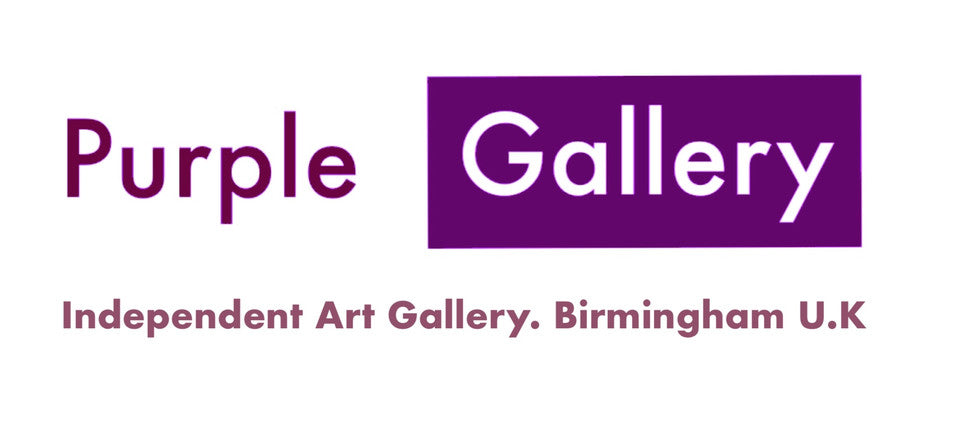Printmaking Terms
Purple Gallery sells Fine Art Prints and Reproductions
Collagraph Derived from the word 'collage’. Collagraphs are created by building up an image on a plate surface (cardboard, metal, or plastic) with glue and other materials thereby creating recessed areas where the ink is retained. Chine Collé is a technique used in conjunction with printmaking processes such as etching or lithography that results in a two-layered paper support: a tissue-thin paper, cut to the size of the printing plate, and a larger, thicker support paper below. Both the tissue and the support sheet are placed on top of the inked plate and run together through the printing press, sometimes with a thin layer of adhesive between them to reinforce the bond produced through the pressure of the press. The process creates a subtle, delicate backdrop to the printed image. Chine is the French word for China, referring to the fact that the thin paper originally used with this technique was imported from China. In addition to China, paper was also imported from India or Japan. Collé is the French word for “glued.”
Drypoint Artists working in drypoint draw the image directly onto the plate using a steel tipped ‘pencil’ that produces an added richness due to the burr (or shaving of metal that is turned up at the furrow). As the burrs are delicate and crush easily under the weight of the press, usually less than 50 impressions can be made.
Etching The metal plate is coated with an acid-resisting wax or ‘ground’ that the artist draws into with a variety of tools, removing the ground from the areas that are to print black. The plate is immersed in an acid bath, which ‘bites out’ or etches the exposed areas. The etched plate is inked and the surface is wiped clean, leaving ink only in the etched depressions. Finally the plate is run through a press with dampened paper - the pressure forces the paper into the etched areas of the plate, transferring the ink onto the paper. Rembrandt van Rijn first popularized this technique.
Giclee The French word "giclée" is a feminine noun that means a spray or a spurt of liquid. The word may have been derived from the French verb "gicler" meaning "to squirt". The term "giclée print" suggests an elevation in printmaking technology. Images are generated from high resolution digital scans and printed with archival quality inks onto various substrates including canvas, fine art, and photo-base paper. The giclée printing process provides better color accuracy than other means of reproduction.
Intaglio prints can be created through a number of processes, the common element is that the printed area is recessed. These recessed areas are filled with a greasy printer's ink and then the surface is carefully wiped clean so that the ink remains only in the incised design. Types of intaglio include; Etching, Drypoint, Aquatint, Mezzotint, and Collagraphs.
Monotypes & Monoprints These two terms are often incorrectly assumed to be the same, but there are important differences. A Monoprint has a single underlying image (such as an etched plate or screen) that is made unique through a process of hand colouring or surface alteration to the printed image. A series of monoprints may be similar but are not identical. Monotypes are unique images and do not have a repeatable matrix (etched plate or screen). Instead, a thin even film of ink is rolled on to a plate which the artist then manipulates by drawing into it, or by rubbing sections off. The print image is taken directly from the plate.
Relief Printing This is the oldest printing technique and refers to the cutting away of part of the surface of a block of material so that the image area to be printed stands out in relief. Woodcuts or woodblock prints are made by cutting into the surface of a smooth piece of hardwood with a knife, and V and U gouges are used to create more delicate lines. When printed, the area that has been cut away remains white and the raised surface prints. A separate block is required for each colour. Printmakers rarely use more than three or four colours for aesthetic reasons. The linocut, a twentieth century adaptation, uses linoleum in place of wood and while it is easier to work with, it will not take very delicate or subtle cutting. Within relief printing, a Reduction Print is a multicolour print in which the separate colors printed from the same block at different stages. Usually, the lightest color of the design is printed first, then the block is "reduced" by carving to the areas which the artist wants to print the second colour from, and so forth. The disadvantage of reduction printing as opposed to printing from multiple blocks is that once the first colour is printed, the matrix for it is destroyed in the creation of the printing matrix for the second colour. It is impossible to undo mistakes.
Silkscreen & Screenprinting A twentieth century multicolour printmaking technique developed in America. The stencil process involves placing designs on a silk or nylon mesh screen that is attached to a wooden or metal frame, with the screen fabric at the bottom. Various film-forming materials, as well as hand-cut film stencils and photo-sensitive emulsions, are used as resists. Colour is poured into the frame which is placed in contact with the surface to be printed on. The colour is scraped over the stencil with a squeegee and deposited on the paper through the meshes of the uncoated areas of fabric.
